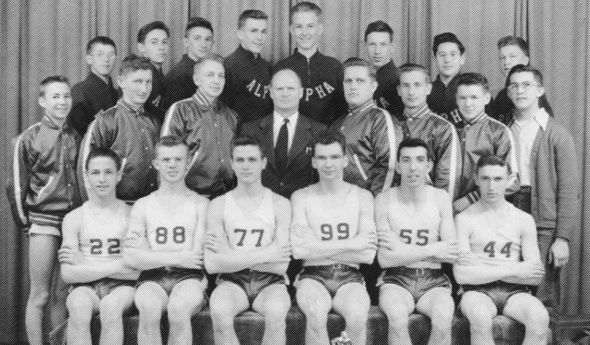
Before the Bridge: Class E & the UP
July 31, 2017
By Ron Pesch
MHSAA historian
This is the final part in a series on MHSAA tournament classification, past and present, that has been published over the last two weeks and originally ran in this spring's edition of MHSAA benchmarks.
The stories are worthy of the silver screen.
Long lost legends of lore, forgotten by most in the Lower Peninsula of the state of Michigan.
Absurd anecdotes of basketball played behind glass, and out-of-bounds lines painted on walls.
Tales of overlooked places like Trenary and Champion and Doelle and Watersmeet.
This is the story of MHSAA Class E basketball.
From 1932 to 1947, Michigan's Upper Peninsula did not compete in the state-sponsored basketball tournament. Instead, the U.P. held a separate basketball tournament, crowning champions in Classes B, C and D. In 1941, the state added a fifth classification – Class E, comprised of schools with a student body numbering 75 or fewer. A fourth bracket was added to the U.P. tourney.
Following the 1948 season, the Upper Peninsula returned to the state tournament. Winners of the traditional U.P. tourney were pronounced regional champions, and advanced to the state quarterfinals in Classes B, C and D. However, since there were no Class E schools with basketball teams in the Lower Peninsula, the winner of the U.P. tournament crown was proclaimed Class E state champion. This arrangement continued through the spring of the 1960 season.
Since they were the state's smallest high schools, the gymnasiums came in all shapes and sizes. Some sported a center circle that intersected with the top of the key. Basketball courts that doubled as a stage required netting to keep the kids and the ball on the court and away from the audience seated below.
Fred Boddy, a former coach at Champion, recalled his first visit to Doelle. Located in copper country near Houghton, the hosts were the proud owners of “the smallest” gym in U.P.
“I couldn't believe my eyes. ... Here on the second floor were windows and bleachers all around filled with fans. The gym, of course, was located on the first floor, but to get into the gym one had to go around to the back of the school to enter through the boiler room to the locker rooms, which opened onto the gym floor much like a dugout on a baseball field. The players sat on a bench under the wall and could look out and see the game in this manner. The free throw lines intersected and there were no out of bounds lines... the wall itself was ‘out of bounds.’ On the floor during the game were 10 players and two referees. There were no sounds as all the fans were up on the second floor, glassed in.
The cheerleaders tried valiantly to fire up the fans up on the second floor, but the teams couldn't hear in the quiet below. The score clock and statistician personnel were placed in a corner box high over the floor in one corner of the gym. They attained this lofty perch by a ladder that was removed from the trap door after all three were in position and the game could thus commence. The timer then tied a rope around his ankle. To send a sub into the game the coach would send the player along the wall heading for this rope. He would pull the rope causing the timer to look down through the trap door and at next opportunity would ring the buzzer and admit this substitute”
Regardless of the challenges presented by these cracker-box gyms, the fans loved their basketball. “The enthusiasm was just the same, if not bigger, than schools twice and 10 times their size,” noted longtime U.P. historian, Jay Soderberg.
Coach Joseph Miheve's 1941 Palmer squad captured the state's first Class E title with a 39-28 win over Hulbert at Ironwood. A graduate of Wakefield High School, Miheve had never played high school basketball, serving as the team's manager.
The 1942 tournament, scheduled for March 19-21, was postponed one week because the city of Marquette was more or less taken over “by nearly 1,000 selective service registrants from every county in the Upper Peninsula” who had another and more serious battle in mind – World War II.
Palmer, this time coached by Elvin Niemi, repeated in Class E with a 37-31 victory over Bergland. It was Palmer's 32nd consecutive victory.
No tournament was held in 1943 due to the involvement of the United States in the war. In the 1944 championship game, Cedarville jumped out to a 19-14 first quarter lead but was held to 24 points in the remaining periods and fell to Amasa, 51-43 at Ishpeming.
Trenary made its lone Class E finals appearance in 1945, losing to Bergland 49-39 at Ishpeming, while the Alpha Mastodons won their first U.P. title since 1934 with a 48-28 win over Champion in 1946. It was the second of five Class E titles for Alpha coach Gerhardt “Gary” Gollakner, one of the finest coaches to come out of the U.P. Gollakner had coached at Amasa two years earlier, and his Mastodons would earn three additional titles during the 19-year run of the Class E championships.
Bergland became the tourney's second two-time winner in 1947, with a 40-37 win over the Perkins Yellowjackets. Perkins made four trips to the Class E finals over the years, including an appearance in the final year of the tournament, but came away empty-handed each time.
The Nahma Arrows made their first appearance in the championship in 1951, losing to Michigamme. Led by coach Harold “Babe” Anderson, a cage star at Northern Michigan College during the early 1940s, the Arrows returned to the finals in 1952. Nahma finished the year with a 21-0 mark and a 64-44 win over Marenisco for the crown.
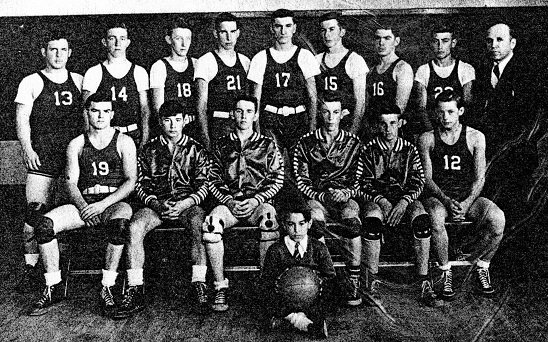 The two teams met again in a finals rematch the following year. The scored was tied six times, while the lead changed hands seven times in this barnburner. With 15 seconds to play, Nahma led 64-60. Marenisco's Robert Prosser hit a jump shot, then teammate Bill Blodgett stole a pass and scored to knot the game at 64. With two seconds remaining, Nahma's Bernard Newhouse was fouled. Newhouse hit the first free throw, but missed on the second. Teammate Wendell Roddy tipped in the rebound, and the Arrows had their second title.
The two teams met again in a finals rematch the following year. The scored was tied six times, while the lead changed hands seven times in this barnburner. With 15 seconds to play, Nahma led 64-60. Marenisco's Robert Prosser hit a jump shot, then teammate Bill Blodgett stole a pass and scored to knot the game at 64. With two seconds remaining, Nahma's Bernard Newhouse was fouled. Newhouse hit the first free throw, but missed on the second. Teammate Wendell Roddy tipped in the rebound, and the Arrows had their second title.
Alpha returned to the championship circle in 1954 with a 52-48 win over Perkins.
The 1955 title game matched a pair of the finest teams in Class E history. Trout Creek, making its first championship appearance, downed Alpha 84-83 in another Class E thriller. Don Mackey led the winners with 39 points. Tony Hoholek paced Alpha with 31, while junior John Kocinski added 21-points for the Mastodons.
Kocinski, a four-year starter at Alpha, scored 1,782 points during his career, then an all-time U.P. record. He once scored 51 points against Amasa, and could have scored more according to teammate Walter “Slip” Ball. “He refused to shoot in the fourth quarter, and passed up one shot after another,” Ball said.
Without question, Trout Creek was one of the powerhouse squads during the final years of the tourney. The Anglers, coached by Bruce “Pinky” Warren, a former captain of Purdue's football team, made four trips to the finals during the last six years of the Class E tourney. The defending champions downed Alpha in the semifinals of the 1956 tournament, then knocked off Hermansville 86-68 in the finals to repeat. It was a year of celebration for fans of U.P. basketball, as four of the state's five champions – Stephenson (B), Crystal Falls (C), Chassell (D) and Trout Creek (E) – came from Michigan's northern peninsula.
Hermansville returned to the finals in the spring of 1957 and earned its second Class E title with a 77-51 win over Michigamme at Escanaba. Trout Creek downed Perkins 61-41 for their third crown in 1958.
The 1959 championship, hosted at Northern Michigan College's fieldhouse, was a showdown of the U.P.’s only undefeated squads, Trout Creek and Nahma. Trout Creek was riding a 24-game winning streak that dated back to the 1958 season. A scoring machine, Warren's Anglers averaged 81.7 points per contest. Nahma, 19-0 on the season, boasted the U.P.'s strongest defense. Still coached by “Babe” Anderson, the Arrows had allowed an average of 38.2 points per game. Led by senior Warren Groleau, Nahma had been last defeated by Trout Creek in the semifinals of the 1958 tourney.
Leading 25-15 at the intermission, Nahma matched Trout Creek point for point in the second half for a 55-45 victory.
Hermansville, behind Richard Polazzo's 29 points and Irwin Scholtz's 27, downed surprise finalist Perkins 72-50 in the 1960 finale, to end this chapter in MHSAA history.
Today, most of the former Class E high schools are long gone. Many have closed their doors and consolidated with other area schools. Amasa and Alpha merged with Crystal Falls to form Forest Park. Palmer is now part of the Negaunee school system. Bergland and Trout Creek joined forces with Class D Ewen to form Ewen-Trout Creek. Hermansville combined with Powers to form North Central, to name but a few. A few remain: Dollar Bay, Marenisco (now Wakefield-Marenisco) and Watersmeet, and their enrollments are much the same as in the glory days of the state's fifth classification.
Author’s note: Special thanks to Jay Soderberg and Roger Finlan, who assisted in gathering statistics and quotes used in this article. Thanks also to Dick Kishpaugh, Bob Whitens, Walter “Slip” Ball, Dennis Grall, Fred Boddy, Bruce Warren, Gene Maki, Harold “Babe” Anderson and the various personnel at U.P. high schools for their contributions to this story.
PHOTOS: (Top) The Alpha boys basketball team won the 1950 Class E title by nearly doubling up Michigamme, 52-28. (Middle) Hermansville claimed the 1948 title with a 58-38 win over Rockland.
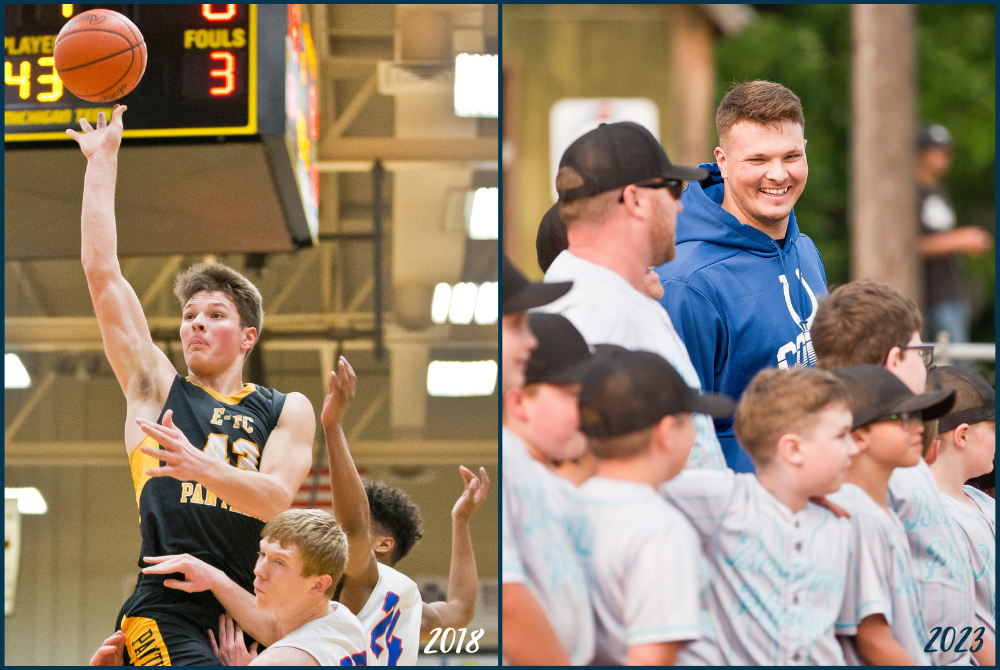
E-TC's Witt Bulldozing Path from Small Town to Football's Biggest Stage
By
Jason Juno
Special for MHSAA.com
June 28, 2024
Ewen-Trout Creek graduate Jake Witt is playing for a spot on the Indianapolis Colts’ 53-man roster. The memories of high school sports, and the impact they’ve had on his journey to the NFL, have stuck with him through his college days and even now as a professional.
 The 300-plus receiving yards he went for in a game against the eventual 8-player state champion back in 2017.
The 300-plus receiving yards he went for in a game against the eventual 8-player state champion back in 2017.
The regular-season basketball game where 3,276 fans turned out to watch his Panthers play just a few months later.
The teamwork prep sports taught him. The family atmosphere he got to be a part of on the high school football team.
“Football was definitely the sport I felt the most family-type feeling with it,” Witt said earlier this week after fishing on Erickson Lake while back in the Upper Peninsula before training camp begins next month. “That’s what drew me back to wanting to play football in college, was my opportunity in high school to play and getting that feeling with the guys and that family-oriented feel.”
Witt played two years of high school football. He lined up exclusively at wide receiver for Ewen-Trout Creek as a junior and then was more of a blocking tight end when E-TC and Ontonagon joined forces as a co-op program when he was a senior.
He ultimately decided to play basketball first in college, at Michigan Tech. But two of his three finalists were football opportunities.
“Obviously playing basketball from second grade on, people would probably assume that I would want to play basketball in college,” Witt said. “I think that just goes to show that football in those two years had a big impact and obviously it led me to where I am when I played at Northern and where I am today.”
Witt played only one year of basketball at Tech. He transferred to Northern Michigan University to attend as a student only before being talked into playing football.
He was initially a tight end there before moving to tackle because of injuries during a game against Ferris State. He dominated, not allowing a sack or even a quarterback pressure against what was considered the best Division II defensive line in the country.
He stayed at tackle for what was left of that season and then all of his final year at Northern. Despite his limited time at the position, he had the attention of NFL scouts and entered the draft. The attention reached a fever pitch during his pro day at Central Michigan when he wowed with his athleticism. His 9.92 Relative Athletic Score, a way to measure players’ athletic testing while accounting for their size, was one of the best for an offensive tackle prospect since it began being used in 1987.
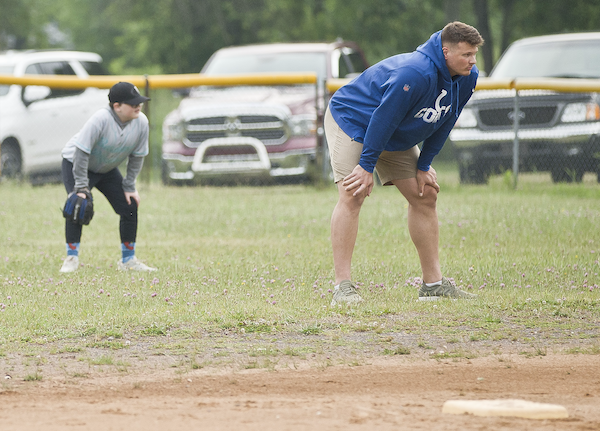 He was drafted with the 236th pick, in the seventh round, by the Colts in 2023.
He was drafted with the 236th pick, in the seventh round, by the Colts in 2023.
His first training camp was cut short due to a hip injury, and he was then placed on season-ending injured reserve. But he’s back healthy and ready to go. He practiced at second-string left tackle during the offseason camp this spring and now hopes to earn a spot on the 53-man roster with training camp set to begin in a month.
“I want to go into training camp, play well and then play well enough to where they can’t release me off the 53,” Witt said. “The next goal is to play in a game. And I think that will start with special teams, that will start with field goal. And then from there, obviously, everybody is one week of great practice away from playing with the offense, one injury away from playing in a game with the offense.”
Those who watched him during his high school days in the U.P. likely wouldn’t be at all surprised to see that happen.
Witt is still the only receiver to go for 300 or more receiving yards in 8-player football in state history, according to the MHSAA record book. And he did it twice, a 325-yard game against Eben Junction Superior Central as a junior and the 305-yard performance against Crystal Falls Forest Park as a senior.
The Ontonagon co-op team had mostly stuck to running the ball that season, but looked for Witt through the air against the eventual state champion Trojans.
“I think it was 345 (yards), I think they sent in the wrong number,” Witt said. “That was one game where we switched things up with our offensive attack and threw the ball a lot more, and it ended up paying off for us very well. We were down big at halftime, and we pushed back and we were in a battle with them in the second half. It was a great game. We didn’t end up winning, but it was a lot of fun.”
He enjoyed both years of high school football – even while mostly blocking on the line as a senior despite having shown previously to be a more-than-capable receiver.
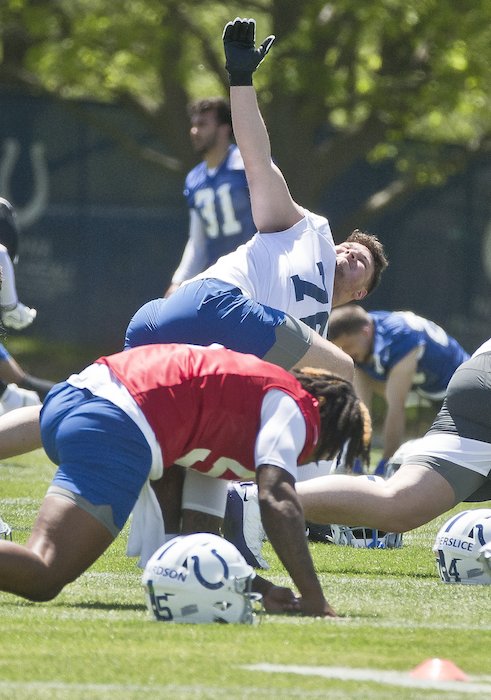 “A lot of the offense wasn’t focused on me anymore, which was great,” Witt said. “It made me a much more well-rounded football player. It made me a much better athlete, it gave me a better perception on things as a football player versus just being a receiver. I think both years were great for different reasons.”
“A lot of the offense wasn’t focused on me anymore, which was great,” Witt said. “It made me a much more well-rounded football player. It made me a much better athlete, it gave me a better perception on things as a football player versus just being a receiver. I think both years were great for different reasons.”
Witt said every sport he played in high school was beneficial to him going forward. Basketball, for example, taught him teamwork and coordination.
“And just relationship building is huge; for me, it helped me move on to the professional football level,” he said.
No high school game was quite as memorable for him as that regular-season basketball game at Michigan Tech on a chilly Wednesday night in Houghton.
Ewen-Trout Creek and Dollar Bay were tied atop the U.P. small-school poll. With that type of matchup, and the chance for fans in the Copper Country to see the 6-7 Witt and his above-the-rim play that’s pretty unique in the U.P., the game was moved from Dollar Bay’s tiny gym to Michigan Tech. (He wasn’t quite 300 pounds like he is now, but he was close – and he came into that game averaging 27 points and 16 rebounds per game with no one able to match his size and strength.)
They expected a crowd; they got 3,276. The latest arriving fans had to sit on the floor on the baseline.
“You don’t see that very much in Division 4 basketball even in the playoffs,” Witt said. “Just having that atmosphere, and especially having it between two of the best U.P. teams at the time, and having the storyline that was behind the game was great – and one of the most memorable events to this day still for me.”
Witt is looking forward to the challenge of training camp and achieving his goals in Indianapolis. But he’s not rushing away a U.P. summer.
He helped out at last week’s U.P. Football All-Star game. He was happy to provide insight for any players headed off to play college ball, and they helped the Marquette County Habitat for Humanity with the finishing touches on one of their houses.
Over the next month, he’ll still be training, going over the playbook and doing position skill work. As happy as he was to help out last week, he’s happy to be on the lake again, too, fishing like a normal Yooper.
“That’s what I’ve been trying to do, that and train,” Witt said. “Just trying to destress before I get back into it.”
PHOTOS (Top) At left, Jake Witt played for Ewen-Trout Creek during a 2018 basketball game at Michigan Tech, and at right Witt takes a photo with area youth baseball players last summer. (Middle) Witt, right, umpires a baseball game last summer. (Below) Witt warms up during the Indianapolis Colts’ rookie camp in May 2023. (Photos by Jason Juno.)

